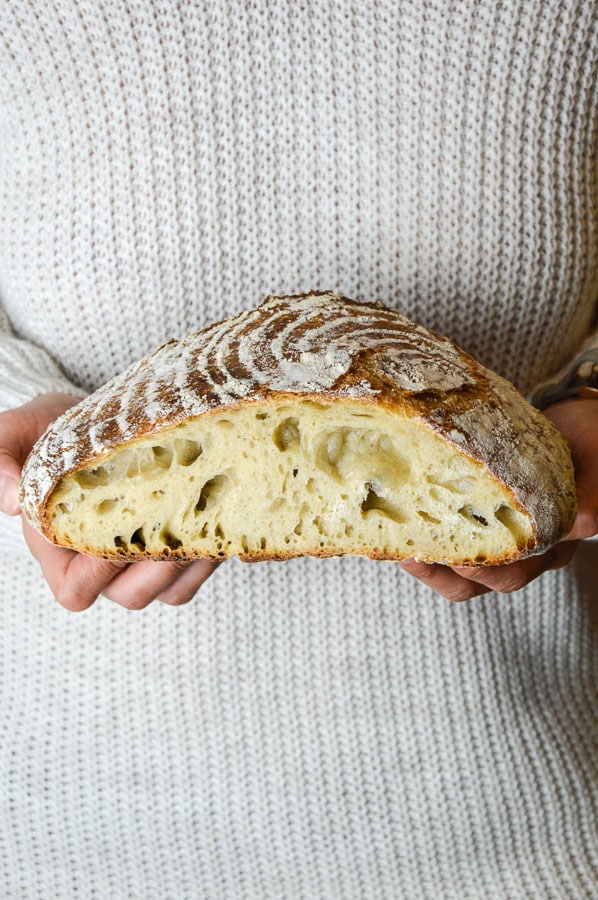How to make bread with sourdough: spelt bread recipe

Last Updated on
Now that more than a month has passed since the coronavirus pandemic forced us all to stay at home, more and more of us have started to make our own bread at home. This has several advantages: on the one hand, it saves us from going out and on the other hand, it provides some entertainment during its preparation. So much so that it has not taken long for fresh yeast to become scarce and we are having to go back to making bread with sourdough.
How to make a spelt bread with sourdough
Although the most normal thing is to make your own sourdough, in Molino de Alcuneza they have put on sale a pack of sourdough that comes with 5 kilos of organic Spelt Fine flour, it has a price of 31.20€ and will save you from having to wait the days it takes to be ready a homemade sourdough, plus this sourdough, if you keep feeding it will last a lifetime.
If we are going to prepare the recipe with this pack we will not use the sourdough as it comes in the jar, but we will feed it before. With this we get the sourdough to gain strength and also, we will have enough quantity to make our breads and to keep the rest in the fridge for future occasions.
Step 1
In a large bowl put 1 kg of organic spelt flour, 20 grams of salt, 600 ml of water and 150 g of natural sourdough.
Mix everything with the help of a wooden spoon and when the ingredients are mixed, continue kneading with your hands for two or three minutes.
We shape the dough into a ball, cover it with plastic wrap and let it rest for 12 to 14 hours at room temperature.
Step 2
After these hours, the starter dough will have doubled or tripled in volume. Add the remaining 500 g of flour, the remaining salt (10 g) and 300 ml of water. Mix and knead by stretching the dough and folding it on itself for two minutes, shape it into a ball, cover with film and let it rest for 10 minutes.
Step 3
Divide the dough into four pieces, lightly knead each of the pieces and shape them into a ball and let them rest for five minutes.
Step 4
Shape each of the pieces. We can make elongated bars or loaves that we will place on baking paper taking care that the joints are facing down. Cover with a clean floured cloth and let them rest until they double their volume.
Step 5
Preheat the oven to 250ºC. We place the loaves on the oven tray, give them a few cuts on the surface with a sharp knife.
We put a tray with water in the bottom of the oven, introduce our loaves and bake at 250ºC for 15 minutes, lower the temperature to 220ºC and bake for 15-20 minutes more.
We will know that the bread is ready when hitting the crust on the bottom with the knuckles sounds hollow inside.
Step 6
We let it cool on a rack so that no moisture is generated under the crust that makes it soften.
Notes
The mother mass that we do not use we keep it in the fridge in a closed jar. When we need to use it again, what we will do is to feed it before. Actually it is always the same process, feed it before using it so that when we remove the amount we need for our bread we still have sourdough left.
If we do not use it for a long time, the sourdough tends to acidify. the sourdough tends to acidify, to prevent this the only thing we have to do is to feed it regularly, that is, if we are not going to make bread in a long time, at least once a week or every ten days, we must feed it and, in this case, throw away the amount we would use to make breads, because there is no need to go accumulating sourdough with each refreshment.
If you are wondering what is the equivalence between fresh yeast and sourdough, I will tell you that when I have no other reference I usually replace the fresh yeast that the recipe calls for sourdough at the rate of 120 grams of sourdough per half kilo of flour. But it is not an exact rule, in fact even in the recipe that I have put today, the proportion is much smaller -50 g of sourdough for every half kilo of flour-, in general, with longer fermentations, the amount we need is less.
Those of you who are starting out, rather than thinking about calculating equivalences, you will be more successful if you look for recipes for breads with yeast or breads with sourdough depending on what you have.

